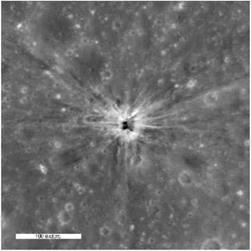Impact Moon
When Neil Armstrong and Buzz Aldrin went outside the lunar module Eagle for their historic moonwalk, one of their tasks was to place a seismometer on the surface that would study moonquakes after they departed. However, the project to produce this instrument was conceived in a hurry. Its power came from two small panels of
The apparent brightness of astronomical objects is slated in magnitudes. A bright star is about magnitude 0. one at the limit of human eyesight is magnitude 6 while the faintest star visible with an Harth-based telescope is about magnitude 25
solar cells and, unfortunately, although it had small radioisotopic heaters, it was seriously damaged by the chill of its first lunar night. It was turned off during the next lunar day.
It fell to the next crew, from Apollo 12, to place on the Moon the first full science station, known as ALSEP, which included a seismometer that drew its power from a self-contained power unit. Subsequently, all missions that reached the Moon’s surface, with the exception of Apollo 17, emplaced seismometers to create a network of stations spread across the near side. From Apollo 13 onwards, all S-IVB stages were steered onto trajectories that led to a violent end, each forming a new crater on the Moon’s surface.
Flight controllers had two major sources of propulsion with which to control the trajectory of the spent S-IVB. The two APS modules had some leftover propellant, and there was still a small quantity of LOX that could be jettisoned through the J-2 engine nozzle under pressure from whatever heat was leaking into its tank. Minor additional thrust could be achieved by dumping the remaining hydrogen from the fuel tank and the helium gas from the pressurising system through two propulsive vents.
 Control of the nearly dead stage was seldom very accurate and controllers never brought their rocket stage down on the Moon closer than 150 kilometres from the planned target. Nevertheless, they were able to track them accurately to their end and the impacts provided lunar geologists with seismic events of known energies occurring more or less in known locations.
Control of the nearly dead stage was seldom very accurate and controllers never brought their rocket stage down on the Moon closer than 150 kilometres from the planned target. Nevertheless, they were able to track them accurately to their end and the impacts provided lunar geologists with seismic events of known energies occurring more or less in known locations.
With each successful S-IVB impact sending lunar shockwaves to increasing numbers of seismometers, the quality of information that could be derived from the travel time of the sound waves improved.
The final network could provide triangulated readings from any impact, natural as well as those due to the S-IVBs and the discarded ascent stages of the lunar modules, yielding detailed information about the The lunar crater formed by the impact of Apollo Moon’s interior. 13’s S-IVB north of Mare Cognitum. (NASA)










